See how to support these key talent management processes using SAP HCM: recruitment, development, training, rewarding, and retaining.
Key Concept
The talent is every employee in an organization: the people who invent, create, design, manufacture, service, support, and otherwise perform tasks required to meet company goals and drive success in the market in which they exist. Talent management is generally defined as the tasks and processes required to leverage individual employee capabilities with a company’s organizational needs in order to drive growth, productivity, and innovation.
The stars of a Hollywood blockbuster or a smash hit on Broadway are referred to as “the talent.” The talent is what any particular work effort requires to ensure a successful outcome, whether that effort is releasing the next movie hit or manufacturing a faster microprocessor.
If an organization wants to become or remain a leader in its market, the talent should be the primary consideration driving the business’ success. Organizational management and industry experts generally agree on these key characteristics of talent management:
- Attract and hire: Plan talent needs, then attract and acquire the best talent
- Align and develop: Enable talent mobility across the organization, match employee skills and potential to individual and organizational goals, and identify competencies crucial to success
- Motivate and retain: Align employee behavior to organizational goals, encourage and enable behavior that aligns and supports organizational goals, retain the highest performers, and reward based on accomplishment
- Educate: Develop employees by targeting their capabilities and knowledge
All of these talent management processes are supported and integrated within SAP ERP HCM. Talent management in an SAP system incorporates the deployment and development of people throughout the entire employment life cycle — from recruitment through development, training, rewarding, and retaining. The four process groupings are represented in Figure 1, along with the SAP modules that support them.
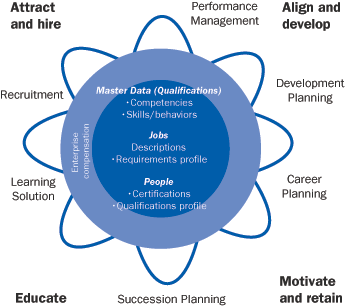
Figure 1
Talent management integration in SAP ERP
The Talent Management Life Cycle
The core SAP HCM talent management data is displayed inside the circle in Figure 1. It consists of qualifications master data, job data, and people data. A second circle represents the SAP Enterprise Compensation Management (ECM) module in SAP ERP, which encompasses data and processes that are integrated throughout the talent management process.
Designing and implementing effective pay reward strategies, as well as analyzing and comparing compensation internally and externally to remain competitive, are processes that occur throughout the life cycle of talent management. Many organizational models display the compensation management process as an individual entity, but since the ECM module in SAP is so tightly integrated throughout HCM and talent management, I’ve imbedded ECM in the foundation of the talent management life cycle.
The SAP HCM modules represented as part of the talent management cycle in this diagram are:
Recruitment: This module allows an organization to identify the appropriate talent quickly, leverage applicant talent when and where it is needed, and maintain relationships with individuals who register in a talent warehouse. You can also report on and track applicants and candidates.
Performance Management: Managing performance means aligning team and individual goals with corporate goals and strategies. By standardizing employee reviews and appraisals and integrating the measurement of employee performance against corporate and personal goals, you can combine performance with compensation and reward processes and identify areas for individual development.
Development Planning: Developing an employee includes improving his skills and talent in his current job as well as preparing and challenging him with new skills, future responsibilities, and new positions. Most organizations expect the development planning process to be a collaborative effort between manager and employee throughout the employment life cycle.
Career Planning: This process enables employees to manage their own career paths and aspirations either through self-service capabilities or as a result of planning with managers. Employee skills and knowledge can be compared with the requirements of specific positions to determine skill and knowledge gaps, which can then be incorporated directly into training plans. Organizations can also implement structured career paths to guide employees through career progressions based on their jobs within the organization.
Succession Planning: Succession Planning allows an organization to identify and track high- potential employees and implement development plans to ensure that they are prepared to assume future leadership roles. You can identify specific positions with key requirements and perform employee searches against this information to determine potential successors.
Learning Solution: This application integrates learning and knowledge acquisition throughout an organization, its customers and its partners through e-learning, classroom training, collaborative learning, and information distribution.
In addition to the core foundation data and the various processes represented in Figure 1, other core data and integration elements support talent management processes, as well as all HCM processes in SAP ERP. Employee Self- Service (ESS) and Manager Self-Service (MSS), reporting, Personnel Administration (PA), and Organizational Management (OM) functions also serve as critical foundation applications for talent management.
In this and several follow-up articles, I will review the key HCM talent management applications and discuss the business processes and practices that most effectively support the talent management cycle. I will describe the integrated talent management components at a high level followed by more detailed articles describing the application and practices of each component. Each function description includes data design and data foundation requirements, integration points with the other applications and functions, implementation considerations, and end-user interaction with the application.
Note
The functionality described in this series of articles is based on mySAP ERP 2004 and later versions. All examples and the data created in the steps described in this article are performed via enterprise core transactions, not via self-service or portal user interfaces.
Qualifications Master Data
Qualifications are one of the key core foundation data elements in SAP HCM talent management. I’ll start by explaining the design and implementation of the qualifications objects in an SAP system.
Skills, competencies, knowledge, and desired behaviors are all synonyms used frequently in referring to the SAP term qualification. Qualification management is often referred to as competency management. The foundation of the talent management cycle in SAP is based on the key qualifications, or competencies, needed to make an organization run successfully.
In SAP, a qualification is a standard delivered object represented by object code Q. When a qualification object is assigned to a person, it is generally referred to as a qualification; when the object is assigned to a job, position, or other non-person object, it is usually referred to as a requirement. The terminology varies, but the object type Q in SAP is the same. This object-to-object assignment allows for a comparison of qualifications held by a person against jobs or positions and the qualifications they require. This concept is the basis of development, career planning, and succession planning in SAP HCM, as well as employee profiles.
The recommended relationship assignment of a qualification to other objects is to link qualifications to the job object. Qualifications linked to jobs are then inherited by the positions defined by the job. There is no limit to the number of qualifications you can assign to a job or position or that can be held by a person. Figure 2 shows the qualification object and its common relationships.

Figure 2
Qualification links
An organization may have a large number of qualifications, so an additional object is used: the qualification group (object type QK). Qualification groups order and group qualifications hierarchically. These groups can contain both qualifications and additional levels of other qualification groups, including the following:
Qualification Attributes: You can create other attributes for qualifications in an SAP system such as proficiencies, alternate qualifications, depreciation, and qualification blocks.
Proficiencies: There are levels or ranges of a qualification that distinguish variations of skill within that qualification. If Six Sigma Green Belt is a qualification that an organization wishes to monitor (both assessed for jobs that require this certification and persons who hold it), you do not need to create different proficiencies.
However, tracking language skills and assigning language requirements to jobs that need bilingual talent may be different. Rather than having a qualification of “Spanish Language,” an organization may want to distinguish between basic and fluent communication skills in Spanish. In this case, proficiency levels will be assigned to the qualification so that the organization can have a greater level of control over what is required for a job and position, and also increase the specific identification of a person’s talent level within the organization.
Alternate qualifications: These allow an organization to assign one or more alternative qualifications to a single qualification. When using matching and searching functions within certain Talent Management modules, alternative qualifications are considered to be the equivalent of, or comparable with, the original qualification.
Depreciation meter assignment: This enables you to specify conditions in which a qualification becomes outdated or diminished if it is not used. If you assign a person (or another planning object) a qualification for which you have defined depreciation meter information, the proficiency of the qualification in question is changed automatically as time passes. You should use depreciation only for those qualifications that a person is not expected to use in the performance of everyday work tasks.
Qualification blocks: These enable you to assign groups, or “blocks,” of qualifications to other objects. They serve the same purpose as assigning individual qualifications to positions, jobs, and persons. Assigning one qualification in a qualification block to an object results in an automatic system assignment of all the qualifications in the qualification block to the object.
Alternate qualifications, depreciation, and qualification blocks are often viewed as non-critical elements in the initial definition and use of the qualifications in talent management, and so they are often implemented in later phases.
Key Integration Points
The integration points between qualifications and talent management modules in Figure 1 are:
- Organizational Management (jobs): Qualifications are stored at the job level and inherited by positions
- Personnel Administration (people): Determine who should hold specific positions based on the requirements of the position and the qualifications of the individual
- Performance Management, Development Planning, and Career Planning: Qualifications allow the identification, monitoring, and measurement of employee skill sets as well as gaps and areas for improvement. The system automatically inserts qualification deficits in performance appraisals as objectives.
- Succession Planning: Qualifications are used as search criteria and in suitability comparisons to determine if potential successors’ skill fits for key positions in the organization
- Learning Solution: Qualifications can be updated automatically when training is successfully completed
- Recruitment: Identification of qualifications that are required for vacant positions and of the best talent match for position
Design of Qualifications
An SAP system contains a table structure that is designed to hold the qualification objects in a logical and manageable form. This table is generally referred to as the qualifications catalog. Before you can assign qualifications, you must create them in the qualifications catalog. Using data from the qualifications catalog, the organizational structure, and employee data, you can then create profiles for persons and positions. These profiles are then used to monitor, manage, evaluate, and compare object characteristics. You can use profile match-ups to look for persons who would be suitable for a particular position within the company or for positions that would be suitable for a particular person. If any qualification deficits arise, you can plan further training measures.
The initial design of the qualifications catalog can be challenging, especially if the required qualifications of jobs are not currently and clearly defined in your organization. To begin the process, I suggest using the following list of tasks to help you gather information and make some key decisions about the content of your catalog. The output from this list can provide you with a foundation of basic qualifications that your organization can use to start the catalog creation process.
Step 1. Collect existing job description data for your organization. The level of detail in job descriptions at most companies is widely varied, but at a minimum yours may have some key functional and performance requirements already defined. Review the existing requirements for common factors in areas such as education and company-specific performance standards.
Step 2. Review any company data from job analysis/salary survey providers. Many organizations use salary survey vendors or other professional services companies to perform job analysis or salary survey projects. The job-specific data provided by these companies is an excellent source of content for the qualifications catalog. Be aware, however, that a thorough job analysis report probably contains more detailed data than you require for a catalog, so do not assume that all job analysis data must go into the catalog. For example, most job analysis data contains a section describing the environmental conditions in which a job is performed, which is not typically defined in the catalog.
Step 3. Even if an external source has not performed a job analysis for your organization, you may have used certain methods internally that are similar in scope to what these vendors use. If these types of methods have been used in your organization, review the data that has been collected to determine which items are critical competencies to the organization’s success. Check to see if any of the following have been used in your organization to gather job data:
- Job classification systems (for example, the US Dictionary of Occupational Titles or the Australian Standard Classification of Occupations)
- Job interview data (from internally conducted interviews with position holders, managers, and supervisors)
- Job checklists or task lists
- Procedure manuals and work logs
Step 4. Identify the competencies that have the most impact on whether a person is successful in performing a specific job. If this data has not been collected, start by identifying benchmark jobs and then define these competencies. These competencies will likely be appropriate for the qualifications catalog.
Step 5. Determine how a competency affects business performance within the company. If you are able to identify (either quantitatively or qualitatively) the positive business impact of a skill or competency, it may be one that you should include.
Step 6. Review any minimum qualifications for specific job functions that may be defined by a governing body, state, or regulatory agency with some governance over your organization.
In addition to using the items listed above as a guide, make sure that for a specific job, you distinguish among qualifications, essential job functions, and performance measures. Qualifications are appropriate for your catalog, while essential job functions and performance measures generally serve as performance management and development planning objectives and goals. For example, you might have a job description for a human resources analyst.
A qualification would be one year of experience managing Human Resource reporting database and recordkeeping data. An essential job function would be ensuring that the HR system database records are audited weekly. A performance measure would be completing reporting functions accurately and in a timely manner.
You should also create a basic set of business rules for identifying whether or not a skill, competency, or knowledge item should be defined as a qualification and stored for use in the talent management cycle. For example, you may determine that certifications and licenses will be defined as qualifications, but that the specific skills that are acquired as part of the certification are not broken out as individual qualifications. This type of business rule — to specify a skill that is not a qualification — aids in keeping your qualifications catalog focused on the goal of tracking critical or key competencies.
Suppose your organization determines that Six Sigma-Green Belt certification is a critical competency. This item becomes a qualification, but the specific skills and behaviors that a person demonstrates to become a green belt, such as “Generates creative solutions that eliminate root causes of customer defects,” are not defined as qualifications.
You should also avoid as much as possible including specific educational courses as qualifications. For example, assume that your organization wants to screen, monitor, and track employees who have the skill to use Microsoft (MS) Access. Now assume that the organization decides to put three different courses into the qualifications catalog that result in acquisition of MS Access competency. These courses are called “MS Access Basics,” “MS Access Advanced Reporting,” and “MS Access 303.” If the organization assigns each of these three qualifications to a job and an employee takes one of these three courses and obtains that specific qualification, he would still show a deficit in MS Access — at least from a system perspective.
This is because the job has three qualifications linked to it and the employee would only have one of them. An employee’s qualifications only match his job’s requirements if the job is linked to every one of these three qualifications and the employee had each of them assigned to him. This design approach creates unnecessary repetition and confusion in the qualifications catalog and could lead to potential legal issues.
Instead of the above approach, focus on the unique skill and proficiency level that is acquired as a result of these courses. For example, you could create a single qualification of “MS Access” with three proficiency levels. Then, when an employee completes any course that covers MS Access skills, their qualifications profile can be updated with the appropriate qualification of “MS Access” and the correct proficiency level. You can update the employee profile either via self-services in SAP or automatically if the SAP Learning Solution is implemented.
Considering another example, assume a global organization wants to track language skills. To be able to assign a language requirement to a job and allow persons to hold a language qualification, these language qualifications must be in the catalog. The qualification group “Language” would be created, and within this group you would create multiple qualifications, each representing a single language. The different groupings required to organize the language skills in a logical manner should be considered first. These groupings would be represented by the qualification group object or objects. When a qualification group is defined, you can assign additional qualification groups below it to whatever level is required.
In summary, when reviewing the types of competencies that should be contained in your qualifications catalog, consider including:
- Languages
- Specific technical skills such as software packages and programming languages
- Certifications and licenses
- Specific and measurable functional job and position skills, including leadership and supervisory skills
- Degrees (not specific courses, unless they happen to fall into one of the other qualification groups)
Consider excluding:
- Continuing education courses
- Qualifications that are unique to a small number of jobs
- Behaviors or competencies that are difficult to measure or can only be described in vague terms
- Behaviors or competencies that measure performance
Although some companies have resisted creating qualifications for what are generally termed “soft skills,” others consider some of these to be core competencies. For example, leadership and potential standards such as “Collaboration” and “Creative/Innovative Thinking” may be qualifications (or qualification groups) that most employees in your organization are expected to develop.
I recommend that an organization start with very basic core competencies and skills that are in current use and add qualifications as the need arises.
Accessing the Qualifications Catalog
You can access the qualifications catalog in two ways.
1. Access the IMG and follow menu path Personnel Management>Personnel Development>Master Data>Edit Qualifications Catalog.
2. Call transaction OOQA in the command field of the SAP Easy Access screen (Figure 3).
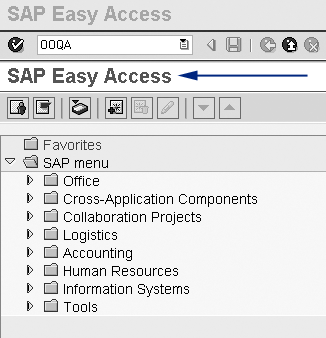
Figure 3
Easy Access link to qualifications catalog
When you access the catalog for the first time, you see the Catalog line (Figure 4). Use the create icon to add qualification groups.
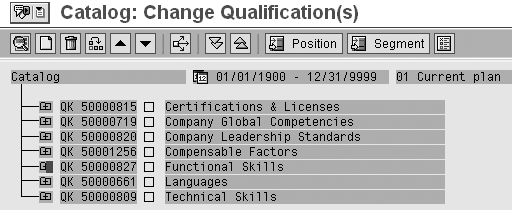
Figure 4
Add qualification groups and qualifications
Figure 4 shows a catalog that contains several first-level qualification groups, such as certifications and licenses. Note that the object key for each of these groups is QK. If you see the object designation of QK, this indicates that a group has at least one additional level of detail. If you expand the line for Languages you see what is shown in Figure 5.
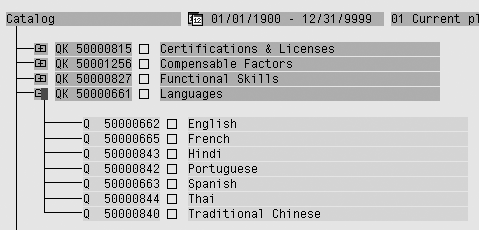
Figure 5
View after you expand the Languages line
Note the seven qualifications under the Languages qualification group in Figure 5: one for each of seven languages. The qualifications are identified by the object type Q. Expand the line for Technical Skills and you see what is shown in Figure 6.

Figure 6
Detail on Technical Skills
Using the Technical Skills qualifications group, you see two additional qualification groups: Programming and Microsoft Office. If you expand the qualifications group for Programming, you see what is shown in Figure 7. In the example shown in Figure 7, the organization determined that there are four programming skills or competencies to track, and defined each of these as a qualification object in the catalog under the qualification group Programming.

Figure 7
View of additional qualification groups
Tip!
You can alter the display of the object type (QK and Q) in the catalog view by turning the display key on and off. To access this function, follow menu path View>Key on/off.
Proficiencies
You can assign proficiencies to qualifications to allow an organization to track levels of skill. For example, for the qualification for language, assume that the organization wants to distinguish an employee’s language skills between three proficiency levels. The qualification group Language would then have a proficiency scale containing three proficiency levels assigned to it.
Proficiencies are set up as scales in table V_T77SP_1. The IMG menu path is Personnel Management>Personnel Development>Master Data>Edit Scales. Figure 8 shows table V_T77SP_1.

Figure 8
Table V_T77SP_1 stores proficiency scales
After you create the scale name and ID, the values of each proficiency in the scale are defined, such as scale 901, Language Scale, in Figure 8. To create the proficiencies, select the Characteristic Values option in the left menu panel.
Figure 9 displays the three proficiencies that are valid for the Language Scale: Basic Understanding, Fluent, and Complex Translation. You then can create a detailed description of each. Figure 10 shows the description for Complex Translation.
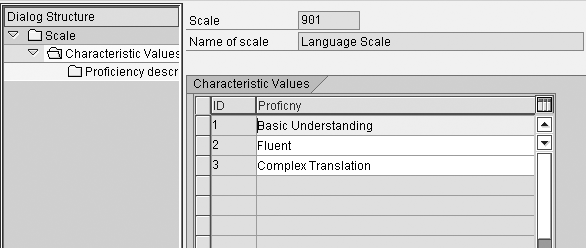
Figure 9
Display of three proficiencies

Figure 10
Description of Complex Translation proficiency
SAP delivers sample proficiency scales and you can configure as many additional scales as you require. Scales can be numeric or text (quantity or quality) and can also be ranges of numbers or simple indicators (such as “yes” and “no”).
In Figure 11, you see a detail view of the qualification Spanish. The scale Language Scale has been assigned to the qualification group Language, which hosts the Spanish qualification. The Spanish qualification then inherits the scale from the qualification group and is displayed at the bottom of the detail window when you access the qualification object in the catalog.
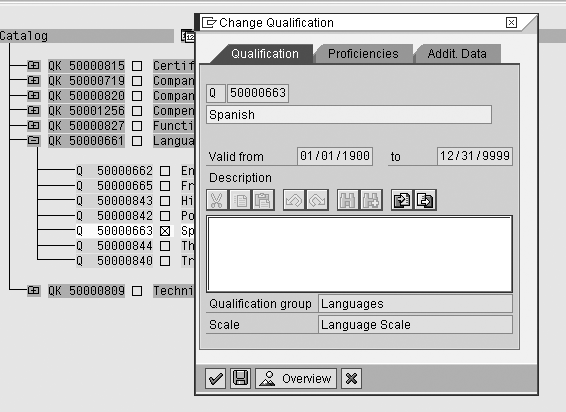
Figure 11
Spanish qualification details
Figure 12 shows the three proficiencies for the Language Scale. Note that the detail window allows display of the proficiencies belonging to the scale that was assigned to the qualification or its qualification group.
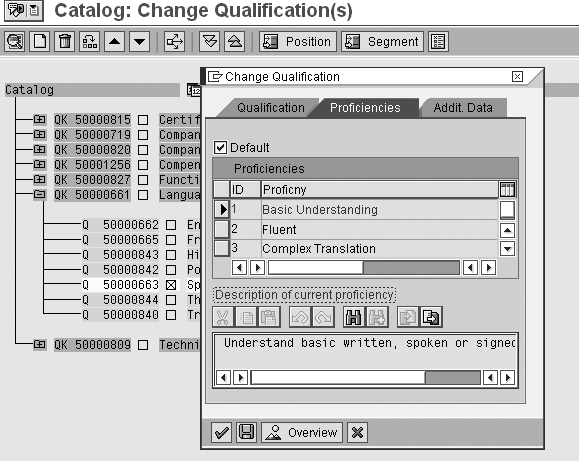
Figure 12
Display of proficiency level
Note
Scales are assigned to qualification groups and are then valid for all qualifications within that qualification group. This means that you need to consider the hierarchy of your qualification groups and qualifications carefully to ensure that it is grouped logically to support the same proficiencies within each grouping.
Proper design of the SAP HCM qualifications catalog will provide the foundation for leveraging additional SAP talent management functions within your organization. The qualifications utilized in your company’s SAP system will drive the processes in Performance Management, Succession Planning, Development and Career Planning, Learning and Recruiting.
In another article, I’ll discuss the assignment of qualifications to jobs and employees and how to enable employee profiles in ESS and MSS.
Janet McClurg
Janet McClurg is an SAP Platinum consultant specializing in the Human Capital Management application. She has worked for SAP for 12 years, the last eight in the platinum consultant role. Janet’s areas of specialization include Enterprise Compensation Management, Performance Management, Organizational Management, Personnel Administration and Succession/Career Planning.
If you have comments about this article or publication, or would like to submit an article idea, please contact the editor.

















